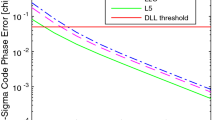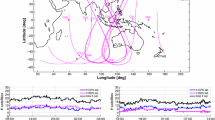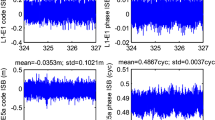Abstract
In this paper, we test the performance of single and dual frequency GPS and Galileo GNSS receivers in terms of satellite-receiver range estimation. In particular, we focus on the effects caused by ionosphere and multipath propagation. Therefore, the available pseudoranges are assumed to be contaminated with first-order ionospheric delay and measurement errors produced in the code tracking stage. We used three dual-frequency methods, two ionospheric models (Klobuchar and NeQuick for GPS and Galileo receivers, respectively) and compared their ionosphere-corrected ranges on a Root Mean Square Error basis. The simulation results showed that a dual-frequency receiver is superior to a single-frequency one, only when the standard deviation of the measurement error is small and when the correlation factor between the two available pseudoranges is higher than − 0.4.
Access this chapter
Tax calculation will be finalised at checkout
Purchases are for personal use only
Preview
Unable to display preview. Download preview PDF.
Similar content being viewed by others
References
Galileo: European alternative to GPS needs more funding (2010), http://www.europarl.europa.eu/news/public/default_en.htm?redirection
Kaplan, E.: Understanding GPS: Principles and Applications. Artech House, Boston (1996)
Odijk, D.: Fast Precise GPS Positioning in the Presence of Ionospheric Delays. PhD thesis, Publications on Geodesy 52, Netherlands Geodetic Commission, Delft, Netherlands (2002)
Klobuchar, J.A.: Ionospheric effects on GPS. In: GPS World, pp. 48–51 (1991)
Radicella, S.M.: The NeQuick model genesis, uses and evolution. Annals of geophysics 52, 417–422 (2009)
Belabbas, B., Schlueter, S., Sadeque, M.Z.: Impact of NeQuick correction model to positioning and timing accuracy using the instantaneous pseudo range error of single frequency absolute positioning receivers. In: ION GNSS 2005, Los Angeles, CA USA, pp. 712–722 (2005)
Skournetou, D., Lohan, E.S.: Ionosphere-corrected range estimation in dual-frequency GNSS receivers. accepted in IET Radar, Sonar and Navigation (2010) (in press)
Engel, U.: A theoretical performance analysis of the modernized GPS signals. In: Position, Location and Navigation Symposium, 2008 IEEE/ION, pp. 1067–1078 (2008)
Kay, S.M.: Fundamentals of Statistical Signal Processing. Detection Theory, vol. 2. Prentice Hall, Englewood Cliffs (1993)
Klobuchar, J.: Ionospheric time-delay algorithm for single-frequency gps users. IEEE Transactions on Aerospace and Electronic Systems AES-23, 325–331 (1987)
Bidaine, B., Prieto-Cerdeira, R., Orus, R.: Nequick: In-depth analysis and new developments. In: Proc. of the 3rd ESA Workshop on Satellite Navigation User Equipment Technologies NAVITEC 2006 [CD-Rom], Noordwijk, The Netherlands (2006)
Parkinson, B.W., Spilker, J.J.J.: Global positioning system: Theory and applications. In: American Institute of Aeronautics, 370 L’Enfant Promenade, SW, Washington (1996)
Prieto-Cerdeira, R., Orus, R., Arbesser-Rastburg, B.: Assessment of the ionospheric correction algorithm for Galileo single frequency receivers. In: Proceedings of the 3rd ESA Workshop on Satellite Navigation User Equipment Technologies NAVITEC 2006 [CD-Rom], Noordwijk, The Netherlands (2006)
Hurskainen, H., Lohan, E.S., Nurmi, J., Sand, S., Mensing, C., Detratti, M.: Optimal dual frequency combination for Galileo mass market receiver baseband. In: IEEE Workshop onSignal Processing Systems, SiPS 2009, pp. 261–266 (2009)
Gao, G.X., Datta-Barua, S., Walter, T., Enge, P.: Ionosphere effects for wideband GNSS signals. In: ION Annual Meeting, Cambridge, Massachusetts (2007)
Hein, G.W., Avila-Rodriguez, J.A.: Combining Galileo PRS and GPS M-Code. Inside GNSS 1, 48–56 (2006)
Mannucci, A.J.: Ionosphere and ionospheric delay, www.cosmic.ucar.edu/summercamp_2005/presentations/Mannucci_Anthony_20050602.pdf (2005) (accessed January 5, 2010)
Misra, P., Enge, P.: Global Positioning System: Signals, Measurements, and Performance. Ganga-Jumuna Press, Lincoln (2001)
Kuusniemi, H., Lachapelle, G., Takala, J.: Position and velocity reliability testing in degraded GPS signal environments. GPS Solutions 8, 226–237 (2004)
Liu, G., Liu, Y.: An methodology of automatic guidance system. In: Proceedings of the 2006 IEEE International Conference on Networking, Sensing and Control, ICNSC 2006, pp. 568–571 (2006)
O’ Keefe, K., Julien, O., Cannon, M., Lachapelle, G.: Availability, accuracy, reliability, and carrier-phase ambiguity resolution with Galileo and GPS. Acta Astronautica 58, 422–434 (2006)
Zhang, J., Lohan, E.S.: Galileo E1 and E5a link-level performances in single and multipath channels. In: International ICST Conference on Personal Satellite Services (PSATS), Malaga, Spain (2011)
WorkingGroupC: Combined performances for Open GPS/Galileo receivers (2010), http://ec.europa.eu/enterprise/policies/satnav/documents/index_en.htm , to be presented in the Fifth Meeting of the International Committee on Global Navigation Satellite Systems (ICG) jointly hosted by Italy and the European Union
Author information
Authors and Affiliations
Editor information
Editors and Affiliations
Rights and permissions
Copyright information
© 2011 ICST Institute for Computer Science, Social Informatics and Telecommunications Engineering
About this paper
Cite this paper
Skournetou, D., Lohan, ES. (2011). Comparison of Single and Dual Frequency GNSS Receivers in the Presence of Ionospheric and Multipath Errors. In: Giambene, G., Sacchi, C. (eds) Personal Satellite Services. PSATS 2011. Lecture Notes of the Institute for Computer Sciences, Social Informatics and Telecommunications Engineering, vol 71. Springer, Berlin, Heidelberg. https://doi.org/10.1007/978-3-642-23825-3_35
Download citation
DOI: https://doi.org/10.1007/978-3-642-23825-3_35
Publisher Name: Springer, Berlin, Heidelberg
Print ISBN: 978-3-642-23824-6
Online ISBN: 978-3-642-23825-3
eBook Packages: Computer ScienceComputer Science (R0)




